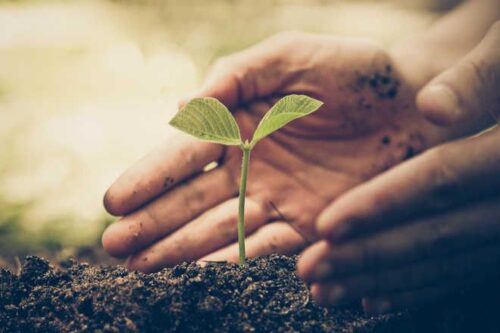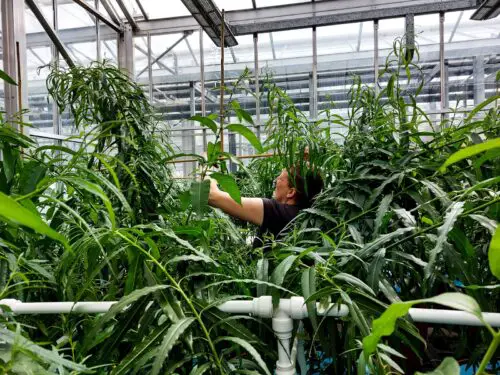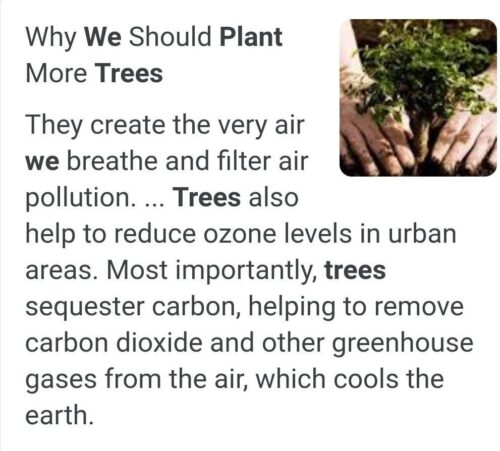Growing more plants and trees increases oxygen levels and improves air quality. This ultimately benefits our health and the environment.
Plants and trees play a crucial role in maintaining ecological balance and mitigating climate change effects. They absorb carbon dioxide, reduce pollution, prevent soil erosion, and provide habitats for wildlife. By planting more greenery, we enhance biodiversity, create a sustainable ecosystem, and beautify our surroundings.
Encouraging the growth of plants and trees also helps in preserving natural resources, conserving water, and promoting a healthier lifestyle. Therefore, it is imperative to prioritize the planting and nurturing of greenery for the well-being of our planet and future generations.

Credit: www.tribuneindia.com
Benefits Of Growing Plants And Trees
Growing more plants and trees has a multitude of benefits that extend beyond their aesthetic appeal. From their positive environmental impact to the health benefits they offer, here’s why it’s crucial for us to embrace a greener approach to life.
Environmental Impact:
Plants and trees play a vital role in shaping our environment. Here’s how:
- Act as Natural Air Purifiers: Trees absorb harmful pollutants such as carbon dioxide, ozone, and nitrogen dioxide, providing us with cleaner and fresher air to breathe. By releasing oxygen during photosynthesis, they contribute to reducing the impacts of climate change.
- Improve Soil Quality: Plants help prevent soil erosion by binding it together with their root systems. The organic matter they produce enhances soil fertility, providing a better environment for microorganisms to thrive.
- Biodiversity Support: Plants and trees create habitats and provide shelter for various animal species. By planting more of them, we promote biodiversity and help maintain the delicate balance of ecosystems.
Health Benefits:
Not only do plants and trees contribute to a healthier environment, but they also have a positive impact on our well-being. Here’s how they benefit our health:
- Natural Stress Relievers: Being in the presence of trees and plants has a calming effect on our bodies and minds. They help reduce stress levels, enhance mood, and promote relaxation.
- Better Air Quality: When we have more plants and trees around us, the air we breathe becomes cleaner. This leads to a decreased risk of respiratory problems, allergies, and asthma.
- Improved Mental Health: The colors and textures of plants and trees provide visual stimulation and promote positive mental health. Studies have shown that interacting with nature reduces symptoms of anxiety and depression.
- Boosted Productivity: Exposing ourselves to green spaces has been linked to increased focus, creativity, and productivity. Incorporating plants and trees into our workspace or learning environment can have a significant impact on our efficiency and productivity levels.
By understanding and embracing the multiple benefits of growing more plants and trees, we can contribute to a greener and healthier planet for ourselves and future generations. Let’s work together to make a positive change!
Importance In Ecosystem
Plants and trees play a vital role in the ecosystem as they help maintain a balance by absorbing carbon dioxide and producing oxygen, which is essential for all living organisms. Additionally, they provide food and shelter for countless animal species and contribute to the overall biodiversity of the environment.
Therefore, growing more plants and trees is crucial for sustaining a healthy and thriving ecosystem.
Oxygen Production
Plants and trees produce oxygen essential for life.
- Reduce carbon dioxide levels in the atmosphere.
- Helps maintain the balance of gases essential for living things.
Habitat For Wildlife
Plants and trees provide shelter and food for various organisms.
- Support diverse ecosystems by creating habitats for animals and insects.
- Preserve biodiversity by providing niches for different species.
Role In Climate Change
Growing more plants and trees is crucial in combating climate change by absorbing carbon dioxide and releasing oxygen. By doing so, it helps reduce greenhouse gas emissions, improve air quality, and prevent soil erosion. Moreover, the additional foliage provides shade, conserves water, and enhances biodiversity.
Carbon Sequestration
Plants and trees play a crucial role in absorbing carbon dioxide from the atmosphere through a process called carbon sequestration.
Mitigating Air Pollution
The greenery provided by plants and trees helps to reduce air pollution by absorbing harmful pollutants such as carbon monoxide and sulfur dioxide.

Credit: www.lettusgrow.com
Socio-economic Advantages
Enhancing the environment by planting more greenery offers numerous socio-economic advantages. Trees and plants help mitigate pollution, provide shade, and improve air quality, fostering healthier communities. Additionally, they contribute to economic growth through increased property values and tourism opportunities.
“Growing more plants and trees not only benefits the environment but also has numerous socio-economic advantages. These benefits extend beyond the aesthetic enhancements and contribute to the economic value of communities. Let’s explore the various socio-economic advantages of growing more plants and trees.”
Enhanced Aesthetics
“Enhanced aesthetics is one of the immediate benefits of growing more plants and trees in our surroundings. Green spaces filled with vibrant vegetation create a visually pleasing environment that uplifts our mood and promotes a sense of tranquility. The presence of plants and trees in urban areas softens the harsh concrete landscape, adding color and texture that appeal to our senses. This aesthetic enhancement significantly improves the quality of life of residents and attracts visitors to these rejuvenating spaces.”
Economic Value
“The economic value of growing more plants and trees goes beyond simply beautifying spaces. It encompasses a wide range of advantages that directly impact the socio-economic well-being of communities. Here are some key economic benefits worth considering: 1. Increased Property Values: Properties adorned with well-maintained green spaces, including gardens and landscaped areas, tend to have higher market values. The serene ambiance and visual appeal offered by these natural settings act as a catalyst for attracting potential buyers and tenants. This increase in property values positively affects the overall economic prosperity of the community. 2. Job Creation: The act of growing and maintaining plants and trees opens up opportunities for employment and entrepreneurial ventures. Professional landscapers, gardeners, and arborists find employment in the horticulture and gardening industry. Moreover, nurseries and plant nurseries thrive, providing a steady stream of business and employment prospects. 3. Tourism and Recreation: Growing more plants and trees can boost tourism and recreational activities in an area. Ecotourism destinations, botanical gardens, and nature parks attract visitors and contribute to the local economy through spending on accommodations, dining, and recreational activities. Green spaces also provide opportunities for outdoor activities such as hiking, picnicking, and bird watching, which further bolster the socio-economic growth of the community. 4. Improved Air and Water Quality: The presence of plants and trees plays a crucial role in improving air and water quality. Trees act as natural air filters, absorbing harmful pollutants and releasing oxygen. This leads to cleaner air, reducing the health risks associated with air pollution. Additionally, plants and trees help stabilize soil and prevent erosion, which enhances water quality by reducing sedimentation. Improved air and water quality positively impact public health and reduce the economic burden of healthcare costs. 5. Energy Conservation: The strategic placement of trees can help with energy conservation. By providing shade in urban areas, trees reduce the need for air conditioning during hot summer months. This, in turn, leads to reduced energy consumption and lower electricity bills for residents and businesses. Energy conservation directly translates to economic savings and contributes to the sustainability of communities. In conclusion, growing more plants and trees brings about substantial socio-economic advantages. The enhanced aesthetics create visually appealing spaces, which in turn enhance property values and attract visitors. Moreover, the economic value of employing people in horticulture and gardening, promoting tourism and recreation, improving air and water quality, and conserving energy further strengthens the socio-economic well-being of communities. By actively promoting the growth of plants and trees, we can create sustainable and prosperous environments for present and future generations.”
Challenges In Plant And Tree Growth
Discover the hurdles hindering plant and tree growth, highlighting the crucial need to foster more greenery. Emphasizing their pivotal role in sustaining biodiversity, combating climate change, and enhancing overall environmental health. Strengthening our dedication to cultivating a greener future for generations to come.
Deforestation
Deforestation poses a significant challenge to plant and tree growth, leading to the loss of crucial habitats and the disruption of ecological balance.
Deforestation leads to the removal of trees, resulting in the loss of critical biodiversity and natural habitats for various species. It reduces the capacity of the environment to support plant and tree growth, impacting the overall ecosystem.
Urbanization Impact
Urbanization also presents challenges for plant and tree growth. The expansion of urban areas leads to the clearing of natural vegetation and significant habitat loss for many species.
Urbanization causes the reduction of green spaces in urban areas, leading to the decline of plant and tree growth as well as the loss of essential ecological functions. This further exacerbates the challenges of maintaining a healthy environment.

Credit: brainly.in
Frequently Asked Questions On Why Should We Grow More Plants And Trees?
Why Should We Plant More And More Trees Around Our House?
Planting more trees around our house is important because they provide shade, improve air quality, reduce noise pollution, and boost our mental and physical well-being. They also attract wildlife, increase property value, and help combat climate change by absorbing carbon dioxide.
So, it’s beneficial for both us and the environment.
Why Are Plants Important?
Plants are crucial for the environment, providing oxygen, food, and habitat for animals. They also help to regulate the climate and provide important medicines. Furthermore, plants support biodiversity and contribute to the preservation of ecosystems.
What Are The Economic Benefits Of Trees?
Trees provide economic benefits by reducing energy costs, improving property value, and boosting tourism. They also support industries like logging and paper production, and can reduce air pollution and water runoff, saving money on infrastructure and healthcare costs.
Why Are Trees Important To The Environment For Kids?
Trees are important for the environment because they produce oxygen, absorb carbon dioxide, prevent soil erosion, provide habitats for animals, and enhance the beauty of our surroundings.
Conclusion
Growing more plants and trees is crucial for our planet’s well-being. By doing so, we not only enhance the beauty of our surroundings, but also contribute to mitigating climate change. Plants and trees purify the air by absorbing carbon dioxide and releasing oxygen, they combat erosion, provide habitat for wildlife, and improve water quality.
Together, let’s join hands in nurturing nature and creating a sustainable future.
